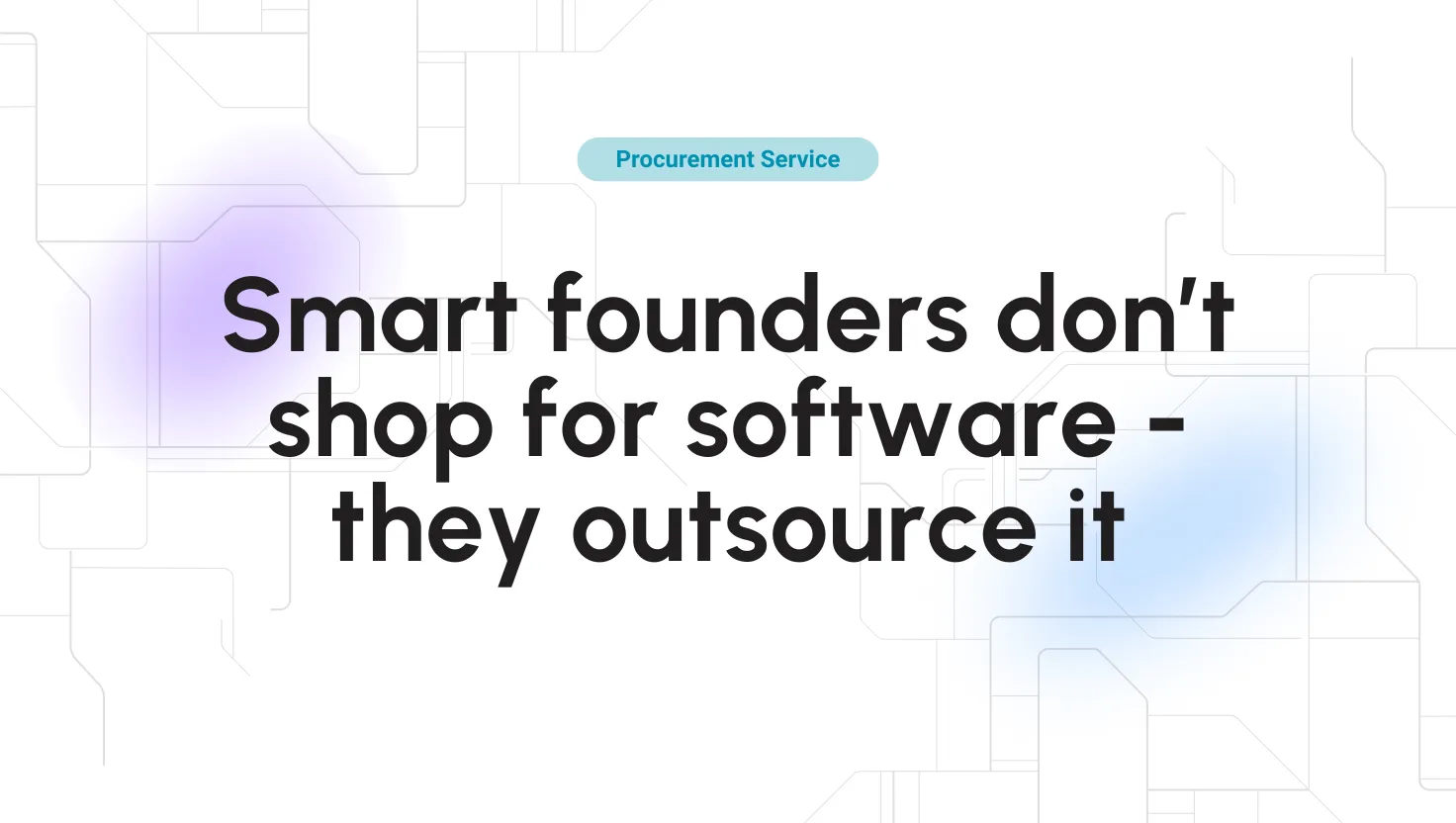Most SMBs don’t realize it, but a SaaS procurement service can be the difference between a lean, profitable software stack and thousands wasted on tools nobody uses.
What is SaaS procurement as a service?
SaaS procurement as a service (sometimes called software buying-as-a-service or outsourced IT procurement) means bringing in an external expert team to manage your company’s software buying end-to-end.
Instead of juggling software research, vendor negotiations, and license management on your own, you delegate these tasks to professionals who specialize in software procurement. This team assesses your business needs, identifies the best-fit software solutions, negotiates with SaaS vendors, and handles purchasing and renewals on your behalf.
Why outsource the software procurement?
Managing SaaS has become complex for businesses of all sizes, especially small and midsize businesses (SMBs) running dozens of cloud apps.
Research indicates that approximately 50% of software licenses remain unused by employees, resulting in roughly $45 million per month in wasted expenditure across organizations.
A lot of small and medium-sized businesses end up paying for tools they don’t need or subscriptions they forget about.
For example, a study found that 37% of employees use three different web browsers for their work, and 31% use two different collaboration tools for the same tasks – definite signs of overlapping subscriptions.
This clutter happens because businesses often don’t have the time or know-how to regularly check their software usage.
Growing demand
Procurement-as-a-service is quickly becoming a popular way to solve this problem. The procurement-as-a-service market is projected to grow ~12% annually (from about $10 billion today to $14 billion in five years). This growth shows that many companies, including SMBs, are turning to outsourced procurement help as a smart strategy for software buying.
Why do SMBs need SaaS procurement help?
The SMB challenge: Small and growing businesses often don’t have a dedicated procurement department. Software buying responsibilities end up scattered between founders, IT guys, or finance teams who may not be procurement experts. This can lead to common pitfalls:
- Wasted spend: Without oversight, organizations often overbuy or forget to cancel unused SaaS licenses, leading to wasted spending. Around half of SaaS expenses may go toward idle licenses, with each unused seat or forgotten auto-renewal costing money.
- Duplicate tools: Different teams may unknowingly use similar apps, leading to multiple tools for the same job (e.g., duplicate project management or chat platforms) and resulting in redundant costs.
- Shadow IT: Employees often sign up for apps independently, leading to untracked subscriptions that inflate the SaaS stack, with shadow IT potentially accounting for ~1/3 of SaaS spending.
- Lack of expertise: Vendors are skilled in sales, while many SMBs lack experience in negotiating software contracts and understanding market prices. Consequently, smaller companies may end up paying more or accepting unfavorable terms.
- Time and Bandwidth: Evaluating software options and engaging with sales reps is time-consuming for busy SMB founders or IT managers, who could better spend their time elsewhere.
SaaS procurement as a service helps small businesses get the most out of their software spending by letting experts handle things. They check how the software is being used, spot any waste, and combine apps when possible.
This way, smaller companies can enjoy the same skills and bargaining power that bigger businesses have, all without having to build those skills themselves.
How SaaS Procurement as a Service works
A typical procurement cycle includes steps like identifying business needs, researching and comparing vendors, negotiating deals, placing orders, and continuous monitoring to eliminate waste.
A procurement-as-a-service engagement usually follows a clear process to optimize your software buying:
-
Discovery & Needs Assessment
The provider begins by understanding your business through a discovery call to learn your goals, challenges, and current software. This helps define your needs and budget by identifying gaps or inefficiencies in your SaaS stack, such as duplicate apps or missing functionality.
Stop chasing vendors. Tekpon can build you a lean, money-saving software stack
-
Stack Audit & Analysis
The procurement team audits your subscriptions, reviewing usage data, feedback, and costs to identify unused licenses, overlapping features, and cheaper alternatives.
If your marketing team is using two similar automation tools, they’ll suggest consolidating into one. They also research the market for better solutions, gathering pricing benchmarks and insights on top tools.
-
Vendor Shortlisting & Recommendations
Based on the analysis, the team will recommend which apps to keep or drop and suggest new solutions based on an analysis of your use cases and budget.
You’ll receive a curated list of software options, informed by the provider’s expertise and market data from SaaS management tools.
-
Vendor negotiation
Once the target software stack is agreed upon, the procurement service enters negotiation mode, reaching out to vendors to secure better deals.
Leveraging their experience and purchasing power, they negotiate volume discounts, inquire about promotions, and push for favorable terms like extended trials and added support.
-
Purchase & Onboarding
After negotiations, the service provides a personalized procurement proposal outlining the selected tools, negotiated pricing, and next steps for implementation.
You’ll have clarity on costs and deliverables. Many providers assist with the purchasing process, coordinating transitions, provisioning software licenses, and facilitating onboarding or training to ensure smooth adoption by your team.
-
Ongoing Monitoring & Optimization
One key benefit of procurement-as-a-service is its ongoing support for managing your SaaS stack. Providers monitor software usage and contract renewals after the initial setup, setting reminders for renewals so they can reassess needs and negotiate to avoid auto-renewal at full price.
They also adjust license counts as your team changes and search for better market options. This partnership helps keep your software spending optimized over time, preventing overspending.
SaaS procurement tools vs services
One question SMBs often have is how a procurement service differs from using a procurement software tool. It’s an important distinction:
Procurement tools (software)
These are SaaS management or spend optimization platforms that help track and analyze your subscriptions. A tool might show you a dashboard of all your software licenses, usage stats, and spending trends.
For example, a SaaS management tool can alert you that 10% of your licenses for a certain app haven’t been used in 90 days, or it can send reminders before a renewal date.
But it won’t negotiate with vendors or cancel contracts for you – that part is still up to you or your team.
Key difference
A tool gives you information; a service does the legwork. With a tool, you’re still in the driver’s seat to execute changes. With a service, you’ve hired a chauffeur – they drive the procurement process for you, end-to-end.
Procurement services (Human expertise)
A service is a team of real people who handle the entire buying process on your behalf. Instead of just giving you data, they take action.
A procurement service actively uses tools and market knowledge to find the best options, negotiates discounts, and sets up deals.
For instance, while a tool may identify overlapping software, the service will determine which one to keep, contact the vendor to cancel or request a refund, and assist with migrating your team to the selected solution.
Every day you wait, you’re paying for software you don’t need. Let Tekpon fix it.
It’s worth noting that this isn’t an either/or situation. Top procurement-as-a-service providers will use advanced software tools as part of their service. They use AI-driven platforms to find unused licenses, benchmark pricing, and monitor usage, combining these insights with human negotiation skills for strategic results.
AI and tools empower the service team, but don’t replace them.
For SMBs, this means you get the best of both worlds: top-class SaaS management technology plus the personal touch of experienced buyers making judgment calls.
Benefits of SaaS Procurement as a Service for SMBs
Why opt for a procurement service instead of doing it yourself?
- Significant cost savings: This is the headline benefit. Procurement specialists can save you money in multiple ways. They negotiate lower vendor prices and eliminate waste by cutting unused licenses and overlapping tools.
- Time savings & Focus: Software shopping is a time sink. By outsourcing it, you and your team reclaim hours (if not weeks) of productive time.
- On-demand expertise (No hiring required): When you use a service, you’re effectively getting an experienced SaaS buying team on call, without adding to your payroll. For a small company, hiring a full-time procurement manager might be overkill or too expensive.
- Optimized software stack (Lean and Effective): Over time, a procurement service will help you streamline your SaaS stack. They identify apps with overlapping functions and suggest consolidating them.
- Vendor-Neutral, Unbiased Advice: A good procurement service acts in your best interest, not the software sellers. For example, our service is 100% independent and vendor-neutral. SMBs benefit from this honest perspective, getting recommendations based on what truly fits their needs.
- Continuous optimization & Support: SaaS procurement isn’t a one-time event – your needs and the software market both evolve. Procurement-as-a-service establishes an ongoing partnership rather than a one-time project.
Final verdict
For SMB founders, a SaaS procurement service isn’t just about buying software – it’s about buying smarter. The right partner cuts waste, saves you time, and builds a stack that works for your business.
See Tekpon’s procurement plan. One call could cut your SaaS costs fast.

